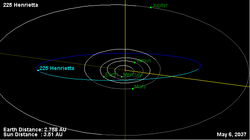Astronomy:225 Henrietta
 Orbital diagram | |
| Discovery | |
|---|---|
| Discovered by | Johann Palisa |
| Discovery date | 19 April 1882 |
| Designations | |
| (225) Henrietta | |
| Pronunciation | /hɛnriˈɛtə/ |
| Named after | Henrietta Jansen |
| A882 HA | |
| Minor planet category | Main belt (Cybele) |
| Orbital characteristics[1] | |
| Epoch 31 July 2016 (JD 2457600.5) | |
| Uncertainty parameter 0 | |
| Observation arc | 120.87 yr (44,148 d) |
| |{{{apsis}}}|helion}} | 4.28364 astronomical unit|AU (640.823 Gm) |
| |{{{apsis}}}|helion}} | 2.4945 AU (373.17 Gm) |
| 3.38907 AU (506.998 Gm) | |
| Eccentricity | 0.26396 |
| Orbital period | 6.24 yr (2,278.9 d) |
| Average Orbital speed | 16.2 km/s |
| Mean anomaly | 159.155° |
| Mean motion | 0° 9m 28.703s / day |
| Inclination | 20.872° |
| Longitude of ascending node | 197.113° |
| 104.149° | |
| Physical characteristics | |
| Dimensions | 120.49±2.5 km |
| Rotation period | 7.3556 h (0.30648 d) |
| Geometric albedo | 0.0396±0.002 |
| C | |
| Absolute magnitude (H) | 8.72 |
225 Henrietta is a very large outer main-belt asteroid. It was discovered by Austrian astronomer Johann Palisa on April 19, 1882, in Vienna and named after Henrietta, wife of astronomer Pierre J. C. Janssen.[2] The asteroid is orbiting at a distance of 3.39 AU from the Sun with a period of 6.24 years and an eccentricity (ovalness) of 0.26. The orbital plane is inclined at an angle of 20.9° to the plane of the ecliptic.[1] 225 Henrietta belongs to Cybele group of asteroids and is probably in a 4:7 orbital resonance with the planet Jupiter.[3]
This is classified as a C-type asteroid and is probably composed of primitive carbonaceous material. It has a very dark surface, with an albedo of 0.040. Photometric measurements made from the Oakley Southern Sky Observatory during 2012 gave a light curve with a period of 7.352±0.003 h and a variation in brightness of 0.18±0.02 in magnitude. This is consistent with a synodic rotation period of 7.356±0.001 h determined in 2000.[4] In 2001, the asteroid was detected by radar from the Arecibo Observatory at a distance of 1.58 AU. The resulting data yielded an effective diameter of 128±16 km.[5]
References
- ↑ 1.0 1.1 "225 Henrietta". JPL Small-Body Database. NASA/Jet Propulsion Laboratory. https://ssd.jpl.nasa.gov/sbdb.cgi?sstr=225;cad=1.
- ↑ Schmadel, Lutz D. (2007). "(225) Henrietta". Dictionary of Minor Planet Names. Springer Berlin Heidelberg. p. 35. doi:10.1007/978-3-540-29925-7_226. ISBN 978-3-540-00238-3.
- ↑ Kasuga, Toshihiro et al. (June 2012). "AKARI/AcuA Physical Studies of the Cybele Asteroid Family". The Astronomical Journal 143 (6): 11. doi:10.1088/0004-6256/143/6/141. 141. Bibcode: 2012AJ....143..141K.
- ↑ Moravec, Patricia; Cochren, Joseph; Gerhardt, Michael et al. (October 2012), "Asteroid Lightcurve Analysis at the Oakley Southern Sky Observatory: 2012 January-April", The Minor Planet Bulletin 39 (4): 213–216, Bibcode: 2012MPBu...39..213M.
- ↑ Magri, Christopher et al. (January 2007), "A radar survey of main-belt asteroids: Arecibo observations of 55 objects during 1999 2003", Icarus 186 (1): 126–151, doi:10.1016/j.icarus.2006.08.018, Bibcode: 2007Icar..186..126M, http://echo.jpl.nasa.gov/asteroids/MBAs/magri.etal.2007.mbas.pdf, retrieved 2015-04-14.
External links
- The Asteroid Orbital Elements Database
- Minor Planet Discovery Circumstances
- Asteroid Lightcurve Data File
- 225 Henrietta at AstDyS-2, Asteroids—Dynamic Site
- 225 Henrietta at the JPL Small-Body Database
 |

